Labeling your dried herbs for tea blends is essential for maximizing flavor, safety, and creativity. When you clearly identify each herb, you can quickly grab the right ingredients, saving time during busy moments. This practice also helps you avoid toxic combinations and guarantees you're using the correct amounts for a balanced brew. Plus, it encourages you to experiment with new combinations by making it easy to tweak your blends. Keeping track of freshness and organizing your herbs enhances your overall tea experience, making every cup enjoyable. You'll discover even more benefits that can transform your tea brewing journey.
Benefits of Labeling Herbs
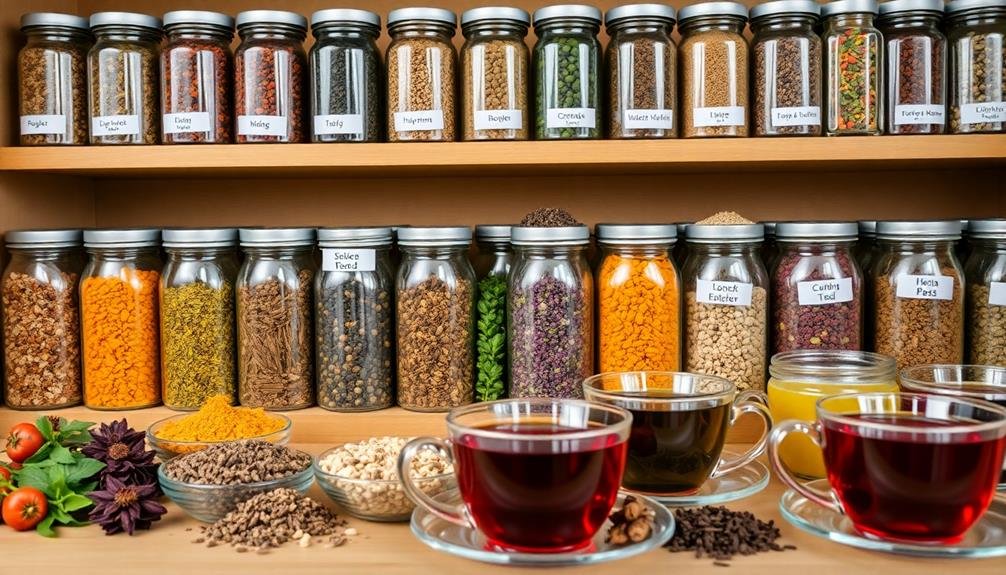
Labeling dried herbs for your tea blends can really enhance your brewing experience. It helps you quickly identify each herb, making it easier to remember which ones you love or want to experiment with.
When you've got a busy day ahead, convenience matters. Labels let you grab what you need without fumbling through jars, saving you precious time.
Additionally, labeling promotes consistency in your blends. By knowing exactly what's in each jar, you can recreate your favorite flavors every time. This consistency not only elevates your tea-drinking ritual but also allows you to refine your blends over time, adjusting proportions to suit your taste.
Another benefit is that labeling can spark creativity. When you see your herbs organized and clearly named, you might feel inspired to try new combinations. You'll be more open to exploring different flavor profiles and finding unique blends that suit your mood.
Essential Information to Include
When labeling your dried herbs for tea blends, it's essential to include clear identification of each herb. This not only helps you blend consistently but also enhances the overall quality of your tea.
Let's explore the key details you should always include on your labels.
Herb Identification Benefits
Identifying herbs in your tea blends not only enhances your brewing experience but also guarantees you're maximizing their health benefits. When you know exactly what herbs you're using, you can better tailor your blends to meet your specific wellness goals. For instance, if you're looking for digestive support, you might incorporate peppermint or ginger, ensuring you reap their unique advantages.
Labeling your herbs helps you avoid mix-ups. Imagine brewing a calming chamomile tea only to find you've accidentally used a stimulating blend instead. This misstep can lead to unexpected results, potentially affecting your mood or sleep.
Moreover, understanding the properties of each herb empowers you to experiment safely. You can mix and match based on your preferences and health needs without risking adverse effects from unknown combinations.
Blending Consistency Importance
Consistency in blending herbs is essential for achieving the desired flavor and therapeutic effects in your tea. When you create a blend, each herb contributes unique properties, and maintaining a consistent ratio guarantees you get those benefits every time you brew. If you alter the proportions, you might end up with a completely different taste or effect.
Here's a simple way to visualize the importance of consistency:
| Herb Type | Recommended Ratio |
|---|---|
| Chamomile | 2 parts |
| Peppermint | 1 part |
| Lavender | 1 part |
Choosing the Right Labels
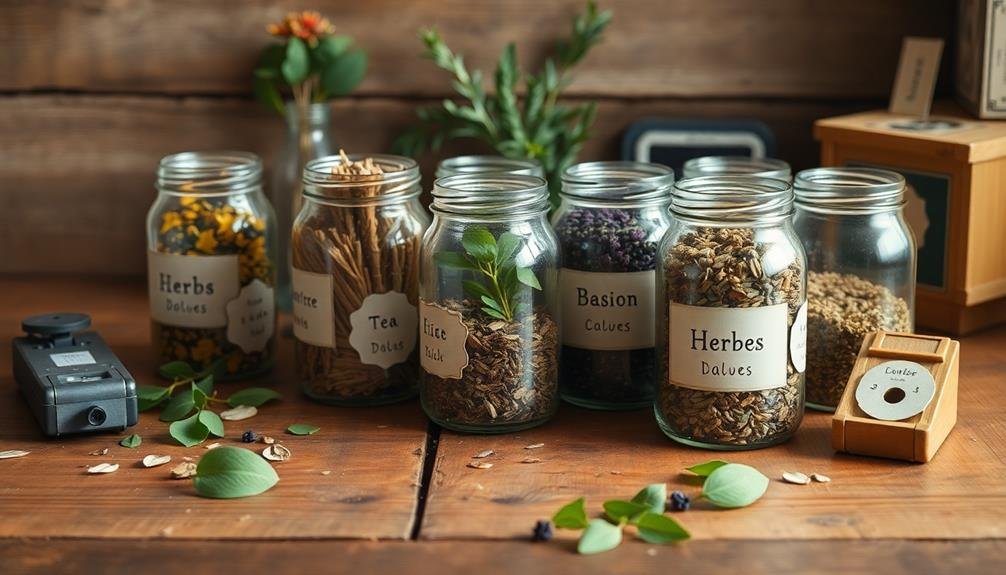
Choosing the right labels for your dried herb tea blends can greatly enhance their appeal and usability. You want labels that not only clearly communicate the contents but also catch the eye of anyone who might be interested.
Consider using waterproof and tear-resistant materials, especially if you plan to store your blends in areas with humidity or moisture.
Next, think about the design. Choose fonts that are easy to read and colors that complement the herbs inside. If you're feeling creative, you might even want to include images or illustrations of the herbs to make your labels more visually appealing.
Make sure you include essential information like the herb name, blend ingredients, and any brewing instructions.
You might also want to indicate the date you prepared the blend for freshness tracking.
Best Practices for Labeling
When labeling your dried herb tea blends, clarity and accuracy are key. You want to guarantee that you—and anyone else who might use your herbs—can quickly identify each blend's ingredients and purpose.
Here's how to do it effectively:
- Use clear, legible fonts: Choose a font that's easy to read, even from a distance.
- Include the blend name: Write the name prominently, so it catches the eye immediately.
- List ingredients: Clearly state all ingredients in the blend, ideally in descending order of quantity.
- Add usage instructions: Include brewing suggestions or any specific notes to enhance the user experience.
- Date your labels: Always add the date when you prepared the blend to keep track of freshness.
Organizing Your Herb Collection

To make the most of your dried herb collection, organizing it efficiently is vital. Start by grouping herbs based on their uses or flavors. For instance, you might want to create sections for calming herbs, digestive aids, or invigorating blends. This way, you'll quickly find the right herb when you're crafting a tea blend.
Next, consider using clear containers or jars. Label each one with the herb's name and any other relevant details, like the date you harvested or dried it. This not only looks appealing but also helps you keep track of your inventory.
If you've got a larger collection, think about using a shelving unit or a dedicated drawer to keep everything tidy and accessible. You might also want to create a simple inventory list. Write down each herb you have and where it's stored. This can save you time and effort whenever you're in the mood to experiment.
Preventing Confusion and Mistakes
To prevent confusion and mistakes when labeling your dried herbs, it's essential you avoid mixing ingredients.
Make sure you measure accurately, as this impacts both flavor and safety.
Avoid Mixing Ingredients
Though it might seem tempting to combine various dried herbs in one container for convenience, doing so can lead to significant confusion and mistakes. When you mix ingredients, you risk losing track of what you have, which can affect your tea blends and your overall experience.
Keeping your herbs separate is essential for several reasons:
- Easier identification: You'll quickly recognize each herb's unique properties and flavors.
- Avoiding cross-contamination: Mixing can lead to unwanted flavors and aromas, making your tea less enjoyable.
- Minimizing errors: You'll reduce the chance of mistakenly using the wrong herb in your blends.
- Maintaining quality: Each herb has its own shelf life; combining them can affect their freshness.
- Better organization: Clearly labeled containers help streamline your tea-blending process.
Ensure Accurate Measurements
Accurate measurements are essential when blending dried herbs for tea, as even a small discrepancy can greatly alter the flavor and potency of your brew. When you label your herbs clearly, you eliminate the guesswork involved in determining how much of each ingredient to use. This guarantees you maintain the same quality and experience every time you make your tea blend.
Imagine you're preparing your favorite herbal mix, only to realize you've added too much of one herb or not enough of another. That can lead to an unbalanced flavor, making your tea less enjoyable. By labeling your jars with precise measurements, you can follow your recipes accurately, guaranteeing each cup is just as delightful as the last.
Additionally, consistent measurements help you track what works and what doesn't. If you discover a blend that's particularly delicious, you can replicate it without hesitation.
Labeling not only saves time but also boosts your confidence in crafting the perfect tea blend. So, take the time to label your herbs clearly and accurately; it's a small step that yields a big difference in your tea experience.
Promote Safe Consumption
Labeling your dried herbs isn't just about measurements; it's also important for promoting safe consumption. When you clearly label your herbs, you help prevent confusion and mistakes that could lead to unwanted reactions or health issues. Knowing exactly what you're using is key to ensuring your tea blends are both enjoyable and safe.
Here are some benefits of labeling your dried herbs:
- Identify Allergens: Clearly mark herbs that may cause allergic reactions, ensuring you or others avoid them.
- Avoid Toxic Mixes: Some herbs can interact negatively. Proper labeling helps you steer clear of harmful combinations.
- Track Freshness: Freshness impacts flavor and safety. Labels can remind you when to use or discard herbs.
- Educate Others: If others are brewing tea with your blends, labels provide essential information on what they're consuming.
- Enhance Enjoyment: Knowing what you're drinking enhances your experience and appreciation for the flavors.
Incorporating clear labels into your herb storage system isn't just a best practice; it's an important step in ensuring that your tea blends are both delicious and safe for everyone to enjoy.
Enhancing Flavor Profiles
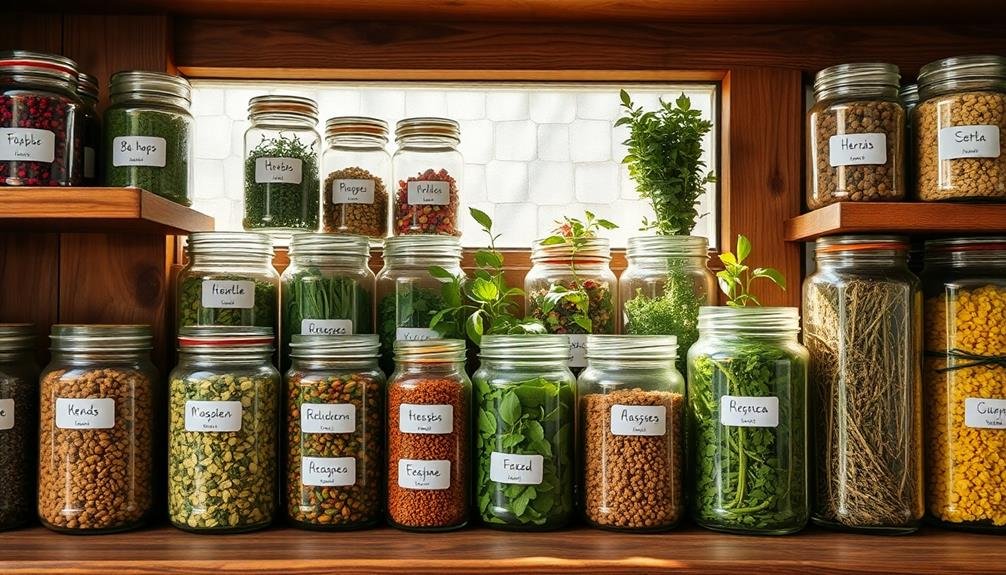
When crafting your tea blends, enhancing flavor profiles can elevate your brew from ordinary to extraordinary. To achieve the perfect balance, you'll want to experiment with various dried herbs and spices. Think about how each ingredient contributes to the overall taste and aroma. For example, adding chamomile can introduce a gentle floral note, while peppermint brings an invigorating zing.
Consider pairing complementary flavors to create depth. For instance, mixing ginger with lemongrass can provide a warm, zesty kick, while a hint of lavender can soothe the senses.
Don't forget about the importance of balancing sweet and earthy tones; a touch of hibiscus can add tartness, balancing well with the sweetness of licorice root.
Labeling your dried herbs helps you remember their unique flavor profiles, making it easier to recreate your favorite blends. You'll become more confident in experimenting, discovering new combinations that delight your palate.
With practice, your tea blends won't only taste better but will also cater to your personal preferences, allowing you to craft your perfect cup every time.
Tracking Freshness and Quality
Keeping track of expiration dates is essential to maintaining the freshness of your dried herbs.
You'll want to regularly assess their flavor profiles to make certain they still deliver the taste you love.
Monitor Expiration Dates
To guarantee the quality of your dried herbs, regularly monitor expiration dates. Keeping track of these dates not only helps maintain the potency of your herbs but also guarantees that you're brewing the best tea blends possible.
Over time, dried herbs can lose their flavor and medicinal properties, which can greatly impact your tea experience.
Here are some tips to help you monitor expiration dates effectively:
- Label each container with the purchase date and expiration date.
- Check your stock every few months to identify any herbs nearing expiration.
- Store herbs in a cool, dark place to prolong their shelf life.
- Rotate your inventory by using older herbs first.
- Consider a calendar reminder for checking expiration dates regularly.
Assess Flavor Profiles
Monitoring expiration dates is just the start of ensuring your dried herbs maintain their quality. You need to assess flavor profiles regularly to guarantee your tea blends taste their best. Freshness plays an important role in flavor, and herbs can lose their potency over time.
To track freshness, take a moment to evaluate the aroma and taste of your herbs. If they lack the vibrant scent you remember, they might be past their prime.
When you brew a cup of tea, pay attention to the flavor. Is it as rich and robust as it used to be? If not, it's time to think about replacing those herbs.
Labeling your dried herbs with harvest dates can help you keep track of how long they've been stored. This way, you can easily assess which ones are nearing the end of their flavor lifespan.
While some herbs may retain their taste longer than others, it's important to trust your senses.
Creative Labeling Ideas
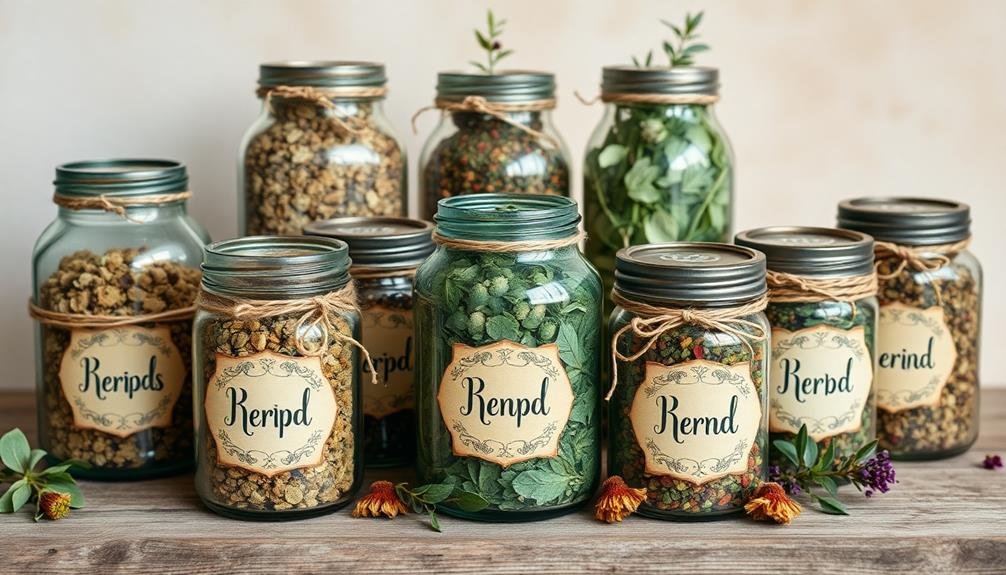
When it comes to labeling your dried herbs for tea blends, think outside the box to make your creations stand out. Unique labels not only help you identify your blends but also add a touch of personality to your herbal collection.
Here are some creative labeling ideas you can try:
- Use Color-Coded Tags: Assign different colors for various types of herbs or flavors, making it easy to grab what you need at a glance.
- Incorporate Drawings or Icons: Add small illustrations that represent the herbs, like a chamomile flower or a peppermint leaf, to enhance visual appeal.
- Craft Personalized Names: Get playful with your blends by creating whimsical names that reflect their taste or mood, like "Relaxing Evening Blend" or "Energizing Citrus Zing."
- Add Descriptive Notes: Include tasting notes or health benefits on your labels to spark interest and provide information at the same time.
- Include Brewing Instructions: Sharing steeping times or recommended pairings can enhance the tea-drinking experience for you and others.
Eco-Friendly Labeling Options
Sustainability is becoming increasingly important, and choosing eco-friendly labeling options for your dried herb tea blends is a great way to contribute. You can start by using recycled paper or biodegradable materials for your labels. These options not only reduce waste but also show your commitment to the environment.
Consider using vegetable-based inks for printing your labels. Unlike traditional inks, these are less harmful and break down more easily. You can even handwrite your labels using eco-friendly markers for a personal touch that adds charm to your blends.
If you're looking for something more durable, explore compostable labels. They're designed to break down in compost piles, minimizing their impact on landfills. Make sure to check for certifications that guarantee their eco-friendliness.
Lastly, avoid plastic altogether. Instead, opt for hemp or jute twine to attach your labels; these materials are both sustainable and stylish.
Frequently Asked Questions
Can I Reuse Labels for Different Herbs?
Yes, you can reuse labels for different herbs, but make sure to thoroughly clean them to avoid any residue or confusion. It's best to write clearly so you can easily identify each herb later.
How Long Do Labels Typically Last on Dried Herbs?
Labels on dried herbs usually last several months, depending on the material and storage conditions. If you keep them dry and away from light, they'll stick around longer, helping you identify your herbs easily.
Are There Specific Materials to Avoid for Herb Labels?
You should avoid materials like paper and non-waterproof labels, as they can fade or deteriorate over time. Instead, opt for durable, waterproof options like vinyl or polyester to guarantee your labels remain clear and intact.
Can I Write Directly on Jars Instead of Using Labels?
Sure, you can write directly on jars instead of using labels. Just make sure to use a permanent marker that won't smudge. It's a quick solution, but consider that it might wear off over time.
What Are Some Common Mistakes When Labeling Herbs?
When labeling herbs, don't forget to include the herb's name and the date. Avoid using vague terms; be specific. Also, guarantee your labels are legible and resistant to moisture. These mistakes can lead to confusion.
In Summary
Labeling your dried herbs for tea blends isn't just practical; it enhances your overall tea experience. With clear labels, you can easily track freshness, organize your collection, and create unique flavor profiles. Plus, choosing eco-friendly options shows your commitment to sustainability. So, take a moment to get creative with your labeling—your taste buds will thank you, and you'll savor every sip knowing exactly what's in your cup. Happy brewing!

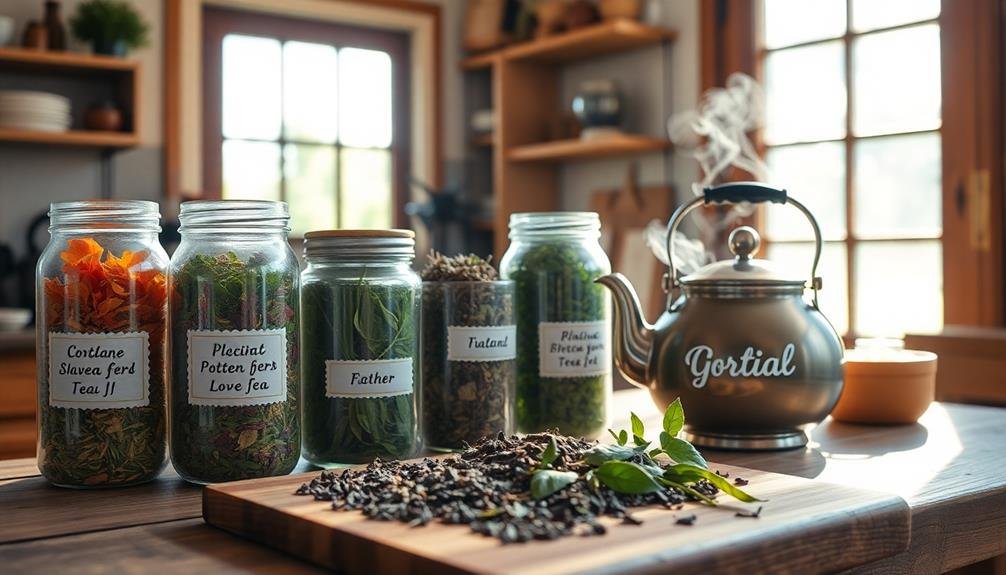



Leave a Reply